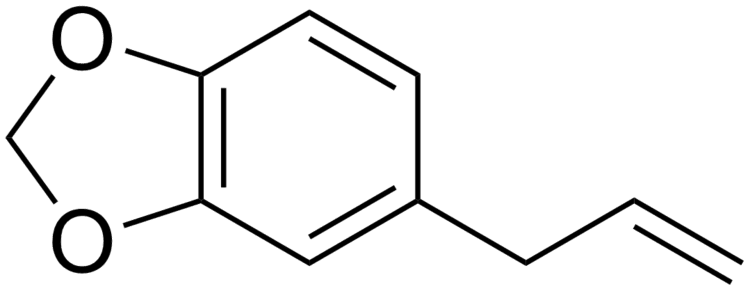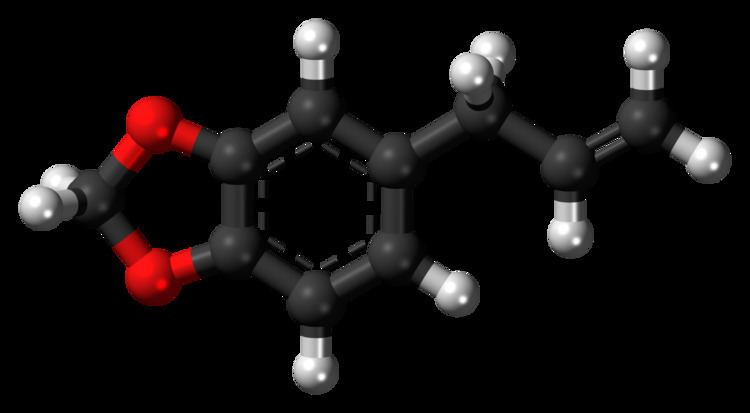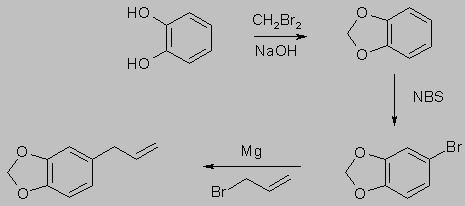Formula C10H10O2 Boiling point 232 °C Melting point 11 °C | Molar mass 162.19 g/mol Density 1.1 g/cm³ | |
 | ||
IUPAC ID 5-(2-propenyl)-1,3-benzodioxole Similar Piperonal, Isosafrole, Estragole | ||
Safrole 3d chemical model
Safrole is a phenylpropene. It is a colorless or slightly yellow oily liquid typically extracted from the root-bark or the fruit of sassafras plants in the form of sassafras oil (although commercially available culinary sassafras oil is usually devoid of safrole due to a rule passed by the FDA in 1960), or is synthesized from catechol or other related methylenedioxy compounds. It is the principal component of brown camphor oil, and is found in small amounts in a wide variety of plants, where it functions as a natural pesticide. Ocotea cymbarum oil made from Ocotea pretiosa, a plant growing in Brazil, and sassafras oil made from Sassafras albidum, a tree growing in eastern North America, are the main natural sources for safrole. It has a characteristic "sweet-shop" aroma.
Contents

It is a precursor in the synthesis of the insecticide synergist piperonyl butoxide, the fragrance piperonal via isosafrole, and the empathogenic/entactogenic drug MDMA.

Carcinogenicity

Studies in the 1960s suggested that safrole was carcinogenic, causing permanent liver damage in animals. Consequently, the US Food and Drug Administration (FDA) banned sassafras and safrole for human consumption.

Safrole is still regarded by FDA to be a weak carcinogen in rats. However, according to a 1977 study of the metabolites of safrole in both rats and humans, two carcinogenic metabolites of safrole found in the urine of rats, 1'-hydroxysafrole and 3'-hydroxyisosafrole, were not found in human urine. The European Commission on Health and consumer protection assumes safrole to be genotoxic and carcinogenic. It occurs naturally in a variety of spices, such as cinnamon, nutmeg, and black pepper, and herbs such as basil. In that role, safrole, like many naturally occurring compounds, may have a small but measurable ability to induce cancer in rodents. Despite this, the effects in humans were estimated by the Lawrence Berkeley National Laboratory to be similar to risks posed by breathing indoor air or drinking municipally supplied water. In the United States, it was once widely used as a food additive in root beer, sassafras tea, and other common goods, but was banned by the FDA after its carcinogenicity in rats was discovered. Today, safrole is also banned for use in soap and perfumes by the International Fragrance Association.
Use in MDMA manufacture
Safrole is listed as a Table I precursor under the United Nations Convention Against Illicit Traffic in Narcotic Drugs and Psychotropic Substances. Due to its role in the manufacture of MDMA, safrole and isosafrole, as well as piperonal, are Category I precursors under regulation No 273/2004 of the European Community. In the United States, safrole is currently a List I chemical.

The root bark of American sassafras contains a low percentage of steam-volatile oil, which is typically 75% safrole. Attempts to refine safrole from sassafras bark in mass quantities are generally not economically viable due to low yield and high effort. However, smaller quantities can be extracted quite easily via steam distillation (about 10% of dry sassafras root bark by mass). Demand for safrole is causing rapid and illicit harvesting of the Cinnamomum parthenoxylon tree in Southeast Asia, in particular the Cardamom Mountains in Cambodia. However, it is not clear what proportion of illicitly harvested safrole is going toward MDMA production, as over 90% of the global safrole supply (about 2000 metric tons per year) is used to manufacture pesticides, fragrances, and other chemicals. Sustainable harvesting of safrole is possible from leaves and stems of certain plants.
